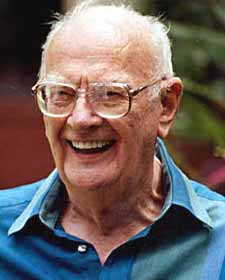Clarke Suggests Geosynchronous Orbit
Writer Arthur C. Clarke first suggested the idea of communications satellites in geosynchronous orbit in the October 1945 issue of Wireless World. Clarke realized that a radio relay station in space could serve a huge area of the earth’s surface, like a radio tower thousands of miles high.
Astronomers and engineers had been probing the uses of radio waves to send signals into space and across earth’s ionosphere since the 1920s. During World War II, the rapid development of radar technology spurred interest in the possibilities of radio astronomy. Arthur C. Clarke, a scientist and popular writer, proposed using radio waves to detect the moon and planets. His interest in space exploration was seated in a deeply-held belief that space travel could be the “moral equivalent to war” and an alternative, peaceful outlet to the rising Cold War tensions unleashed by the spread of nuclear weapons.
In his October 1945 article, Clarke discussed the pressing problem of long-distance telephony and broadcasting. Wireless communications could not travel far across the globe without encountering the distorting effects of the ionosphere. Television broadcasts could not be sent across the ionosphere at all, and demanded a costly infrastructure of repeaters set less than fifty miles apart. Linking television broadcasts across the globe, in turn, would present an even more complex and expensive challenge. “A relay chain several thousand miles long would cost millions, and transoceanic services would still be impossible,” Clarke wrote.
Clarke’s proposed building radio controlled rockets that could send communication satellites into orbit. He believed that the V2 rocket technology developed by the Nazi war machine could be adapted to put “a second moon” into orbit simply by doubling the speed of the rockets. This “space station,” as he called it, would be manned with scientists studying astronomy, physics, and meteorology. It would also serve as a communications hub, relaying communications between any two points on earth. Only a small amount of power would be necessary for a sender to break through the ionosphere and reach the satellite. Although the station could only reach half of the world’s surface at a time, other satellites could be launched at equal distance around the globe and linked by radio or optical beams, allowing for complete coverage of the earth. The high upfront costs of this system, he maintained, were “incomparably less” than the expensive of building a terrestrial communications system.
Further Reading
The 1945 Proposal by Arthur C. Clarke for Geostationary Satellite Communications
